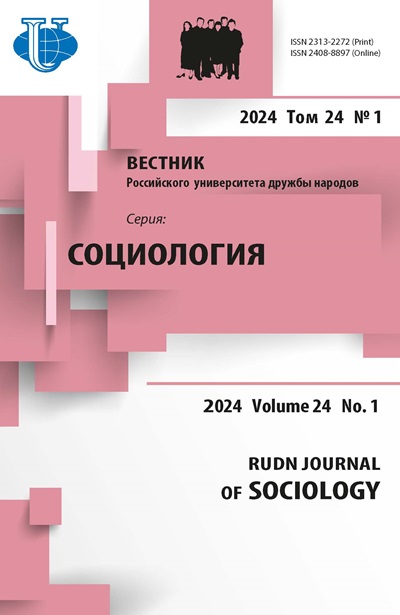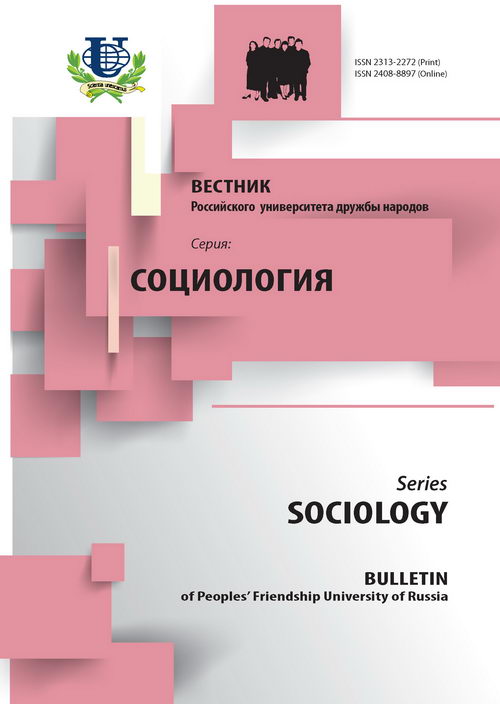Gender identity construction in virtual political communication: Discourse strategies and self-representation practices in social networks
- Authors: Maximova OB1
-
Affiliations:
- Peoples’ Friendship University of Russia
- Issue: Vol 16, No 2 (2016)
- Pages: 403-417
- Section: Surveys, experiments, case studies
- URL: https://journals.rudn.ru/sociology/article/view/6479
Cite item
Full Text
Abstract
The article considers the specifics of gender construction in political virtual communication. The author employs the discursive approach combined with the content analysis to study gender communicative strategies and self-representation practices in social networks. Facebook postings within a viral flash-mob “The Island of the‘90’s” provided the data for the study, and the article explains the rationale for their attribution to political communication. The analysis based on the cognitive model of discourse revealed the three-level structure of flash-mob discourse that reflects different levels of publications involvement into the political context. The comparative analysis of male and female participation in the development of flash-mob discourse helped to identify a pronounced gender asymmetry in both flash-mob discourse structure and its structural levels. The content analysis showed no signs of gender differences disappearance, traditional gender-role patterns weakening or androgyne model manifestation. The results lead to the conclusion that women seem to be more flexible in their representation strategies, and women’s participation in the discourse has less degree of political involvement at all structural levels. The author highlights the theoretical importance of the Internet flash-mob investigation methodology development for the study of virtual political communication.
About the authors
O B Maximova
Peoples’ Friendship University of Russia
Author for correspondence.
Email: maximovaob@mail.ru
Foreign Languages Chair
References
- Butsyik E.D. Konstruirovanie gendernoy identichnosti v politicheskom diskurse [Gender Identity Construction in Political Discourse] // Vestnik MGIMO-Universiteta. 2015. № 3.
- Van Dijk T.A. Yazyik. Poznanie. Kommunikatsiya [Language. Cognition. Communica-tion]. M.: LENAND, 2015.
- Lavrenchuk E.A. Autopoyezis sotsialnyih setey internet-kommunikatsiy [Autopoiesis of Internet communication social networks] // Vestnik RGGU. 2009. № 12.
- Maksimova O.B. Gendernyie aspektyi bloggerskoy politicheskoy kommunikatsii [Gender aspects of political communication in blogs] // Vestnik RUDN. Seriya “Politologiya”. 2012. № 2.
- Maksimova O.B. Gendernyie stereotipy v reklame: postanovka problemyi i osnovnye kontseptsii [Gender stereotypes in advertising: Problem statement and main concepts] // Vestnik RUDN. Seriya “Sotsiologiya”. 2002. № 1.
- Ushkin S.G. Vizualnyie obrazy polzovateley sotsialnoy seti “Vkontakte” [Visual images of “Vkontakte” social network users // Monitoring obschestvennogo mneniya. 2012. № 5.
- Bell P., Milicc M. Goffman’s gender advertisements revisited: Combining content analysis with semiotic analysis // Visual Communication. 2002. № 1.
- Deller R.A., Tilton A. Selfies as charitable meme: Charity and national identity in the #nomakeupselfie and #thumbsupforstephen campaigns // International Journal of Commu-nication. 2015. № 9.
- Eisenlauer V. Facebook: A multimodal discourse analysis of (semi-)automated communi-cative modes // Interactions, Images and Texts: A Reader of Multimodality / Ed. by C. Maier, S. Norris. Berlin: de Gruyter, 2014.
- Garde-Hansen J., Gorton K. Emotion On line: Theorizing Affect on the Internet. London: Palgrave Macmillan, 2013.
- Goffman E. Gender Advertisements. Cambridge: Harvard University Press, 1979.
- Lawton E. Gender Advertisements: Replication of a Classic Work Examining Women, Magazines, and Facebook Photographs. Smithfield: Bryant University, 2009.
- Maximova O.B. Social aspects of Internet communication: Virtual community and com-munication personality // Вестник РУДН. Серия «Социология». 2011. № 1.
- Rheingold H. Net Smart: How to Thrive Online. Cambridge: The MIT Press, 2012.
- Trotsuk I. When methodology beats techniques; or, Why we prefer discourse and narrative analysis to interpret textual data // Социологическое обозрение. 2015. Т.14. №3
- Van Dijk T. A. Discourse and manipulation // Discourse & Society. 2006. № 17.














